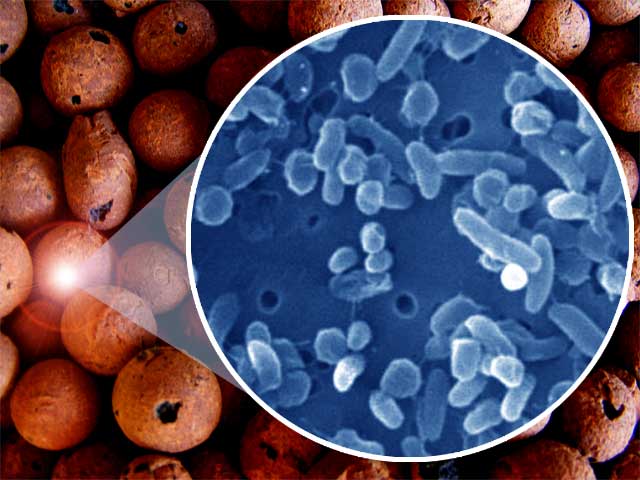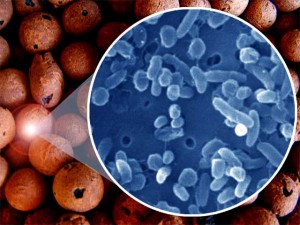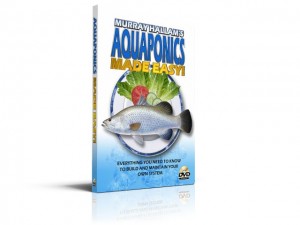Getting an Aquaponics system started with Bacteria
They are probably the hardest little workers you never get to see or meet or even shake their hand – if they had such a thing. Well actually that’s not entirely true. In fact you do get to shake their hand every time you plant a new seedling in your aquaponics system or plunge your hand into the water to check your fish.
Bacteria are the little microscopic creatures that do all the work in an Aquaponics system converting fish waste into food that your plants can absorb. Hundreds and billions of them chugging along, multiplying, eating and dancing away, unseen in your aquaponics water, in your grow bed, adhering to the underside of your old pump, the slime coating of your fish and onto the fingers of your hand when you touch the gravel media that make up your aquaponic system.
Bacteria are in fact everywhere.
Without them, the system would fail. The plants wouldn’t grow. The fish would all die and the whole thing would come to a grinding, crashing halt. In fact life as we know it would probably end the same way as it did for the aliens in H.G. Wells “The War of the World!”
Bacteria are the living engine that process fish waste, breaking down and mineralization the elements and converting poisonous ammonia into something that the plant roots can readily absorb.
“After all, you are building a living eco-system that encourage microscopic bacteria to do a majority share of the work.”
So how do you attract the right bacteria into your aquaponics system if you are just starting out? Where do you get them from? Some people do actively try and sell little flasks of bottled bacteria in water to unsuspecting new comers to aquaponics – but the beautiful part about all this is that you don’t have to buy your bacteria from anyone. In fact they are free. They are all around you in the air as you breathe but remain inert until something magic happens. And that’s where you come into the picture. Because if you offer them the right conditions, the right temperature and some yummy nutrients and build them a nice cozy little aquaponics system – you’ll find like all good tenants – they will move right into your system and start breeding and creating a living ecosystem. Adding compost worms into your system later on will encourage the worms to break down fish waste even further and all sorts of small insects and living creatures will soon move into your system as the days and weeks pass and the system gradually establishes itself.
A Living Eco-System
But getting the system to age well without creating too much disruption is the name of the game. A new aquaponics system with fresh water added will have very little bacteria in the system especially if its town water that’s been chlorinated. Adding a large number of fish at this early stage can create serious problems if the system hasn’t developed properly because there are too few bacteria to handle the sudden load, fish waste, uneaten fish food and other waste that can send the aquaponics system into a spiraling crisis and result in mass fish deaths as the fish succumb to toxic levels of Ammonia. The early stages of building an Aquaponics system and preventing all your fish from dieing requires some careful pre-planning so the system can gently grow with the right population of bacteria and take off naturally without a strain on your nerves and patience. After all, you are building a living eco-system that encourage microscopic bacteria to do a majority share of the work.
Fishless Cycling
Fishless Cycling is getting your Aquaponics system ready for the fish. It means switching on your pump and oxygenating the water in the fish tank and running the system normally without adding any fish at this stage. You will have bought a suitable test kit at this stage that you will test for four main things. The pH of your water. Is it alkaline or acid? The Ammonia in your system. Nitrite Readings and finally the thing you most want to happen – Nitrate reading which tell you that the system has cycled and the bacteria are converting the fish waste into plant food.
But Rome wasn’t built in a day and you need to be patient if you want to get things started properly.
“A little urine can also be used to start the system cycling. Just be careful about peeing too often into your fish tank!”
Starting a System
Starting a system from scratch requires you to add a little source of pure ammonia to get the ball rolling. Not the cleaning type you find in supermakets which contains other elements such as fragrances and soap which can kill your fish, but a natural form of ammonia. We need to give the bacteria a source of food so they can start multiplying and building a stable colony.
The best way to get your system quickly established is to use water from another aquaponics system where the bacterial colony is already established. Some people add a little Urea or even a dead fish or a few prawns (shrimp) into the tank to start the decomposition process. A little urine can also be used to start the system cycling. Just be careful about peeing too often into your fish tank. One man eager to get his system started ended up urinating three or four times a day into his tank and turned it into a fetid cesspool. He introduced his fish to the system one day and they all promptly died. You can have too much of a good thing! So test regularly as the days progress for small signs of ammonia rising,
This is probably the hardest part of aquaponics. Being patient enough to wait and watch as the system grows. How can you tell if anything is happening? You’ll need a suitable test kit and patience. The best time to start an aquaponics system is in the warmer summer months. The bacteria are more inclined to rapidly grow as water temperatures are in their mid 20 degrees centigrade. During Winter periods you can still get your system cycled but it will take many days and possibly even weeks before the system is fully cycled as the bacteria are more dormant due to the cooler temperatures.
Avoid the kits that have coloured strips that you dip into the water to measure your levels. The best kit we use is the API Freshwater Master Test Kit that has small glass vials that enable you to test for Ammonia, Nitrites and Nitrates and pH. Their results are very reliable and will last a long time.
“Another group of bacteria will now suddenly gate crash this party and start chomping up the Ammonia and converting it to Nitrites.”
The first few days when you start the cycling process not a lot will happen but if you look at the chart above around a week into the process ammonia will start to rise in your tank. Another group of bacteria will now suddenly gate crash this party and start chomping up the Ammonia and converting it to Nitrites.
The Nitrite readings will then begin to rise and in turn attract another group of bacteria to feast on the Nitrites and finally after a number of days, from two to three weeks in Summer, the first signs of Nitrate readings will appear in your test kit. The Nitrates are the thing that plants love to eat and grow.
In aquaponics we try and keep things in balance. Too high a Nitrite reading means you either have too many fish for your growbed or you need to add more growbeds to the system. Some people get concerned that as their system matures – their Nitrate readings become very low and at times disappear! This is generally not a bad thing. It means the plants are consuming the Nitrates at the same rate that the fish are producing the waste. You have a happy system in balance that is now purring along growing your fish and plants with ease. If you want to learn more about this subject, get a hold of Murray Hallam’s Aquaponics Made Easy DVD that goes into this subject in more depth.











Recent Comments